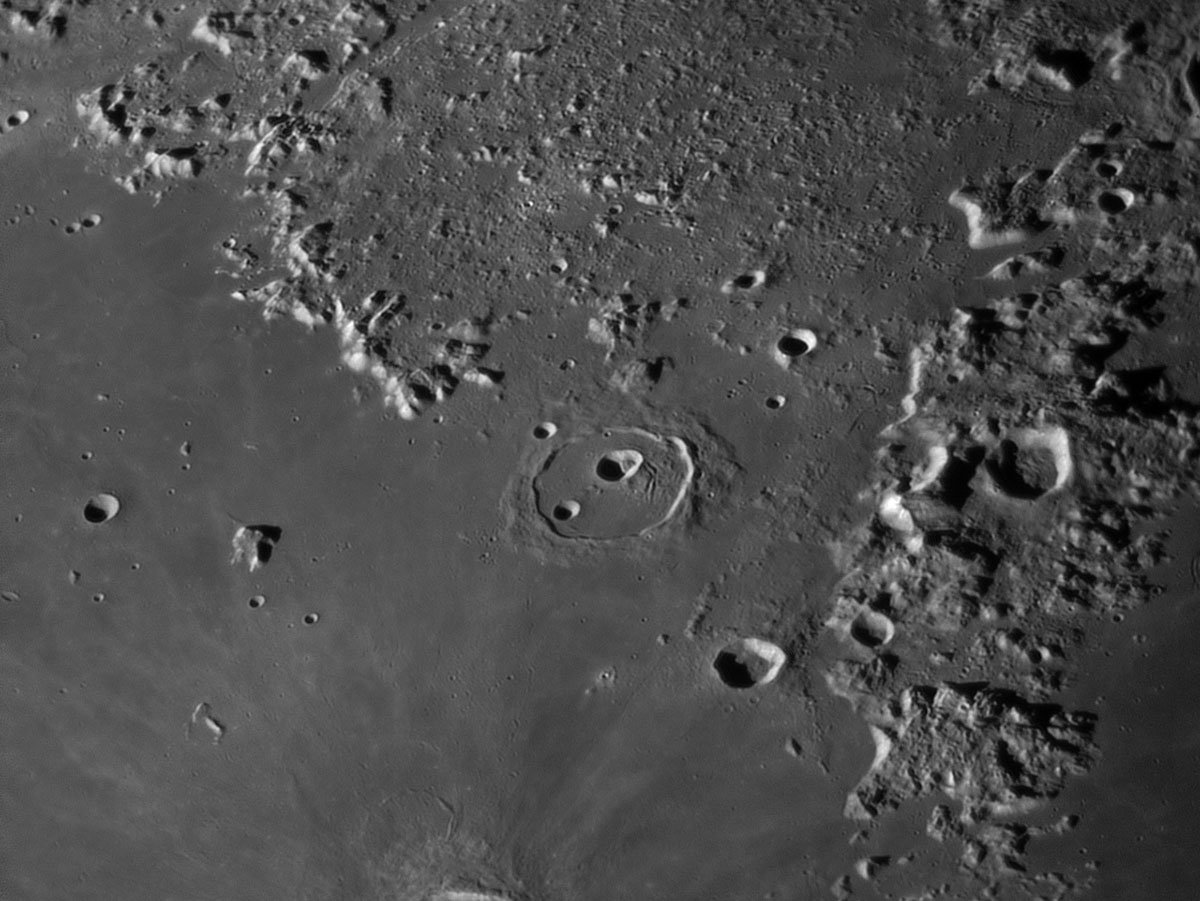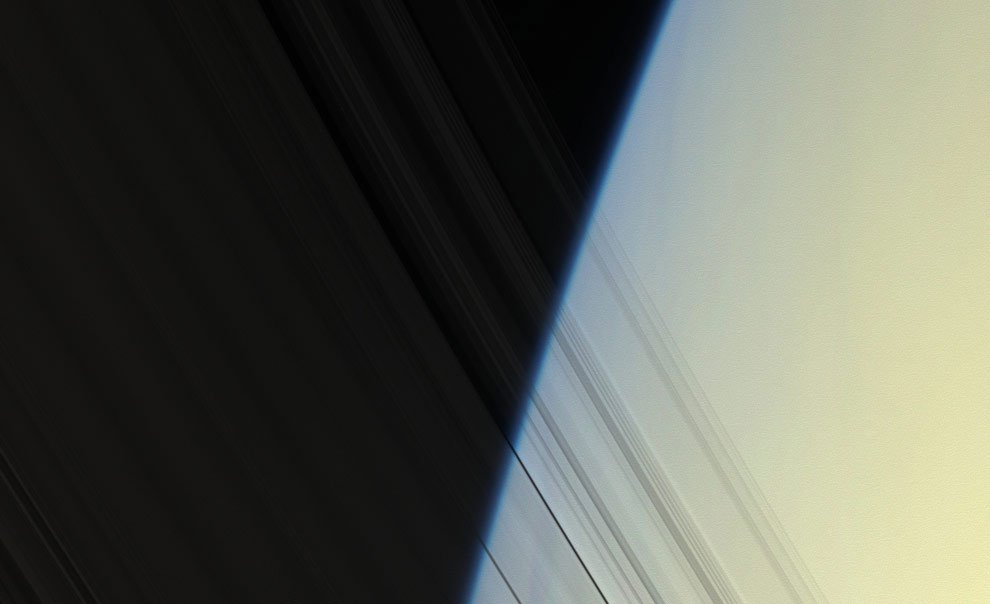
The Cassini spacecraft looks toward Rhea's cratered, icy landscape with the dark line of Saturn's ringplane and the planet's murky atmosphere as a background. Rhea is Saturn's second-largest moon, at 1,528 kilometers (949 miles) across.Images taken using red, green and blue spectral filters were combined to create this natural color view (NASA/JPL/Space Science Institute).
Διατηρούνται οι αγγλικές λεζάντες προς αποφυγή λαθών.

Ο Giovanni Domenico Cassini και στη μικρή εικόνα ο Christiaan Huygens.
Outer Space, διαστημική ποίηση στο φιλμ του Sander van den Berg που χρησιμοποιεί εικόνες από τις αποστολές Cassini-Huygens και Voyager. Μουσική : The Cinematic Orchestra -That Home.

Το Αστεροσκοπείο του Παρισιού με όλα του τα αστρονομικά όργανα.

Το μαρμάρινο άγαλμα του Cassini στο Αστεροσκοπείο του Παρισιού από τον γλύπτη Jean Guillaume Moitte (© Courtauld Institute of Art), και δίπλα η προτομή της γυναίκας του Genevieve de Laistre (Edgar L. Owen Ltd., Gallery of Antiquities).


Χαρτογραφία της Σελήνης από τον Giovanni Domenico Cassini. Διακρίνεται η "κόρη του φεγγαριού" με πρόσωπο και ανεμίζουσα κόμη στη θέση του Ακρωτηρίου των Ηρακλειδών.

Πλάγια όψη από την περιοχή Deuteronilus Mensae της Σελήνης πρός τον κρατήρα Cassini.

Η θέση του κρατήρα Cassini σε σύγχρονο χάρτη της Σελήνης.

Ο μεγάλος κρατήρας Cassini στη σεληνιακή Mare Imbrium με τους δύο μικρότερους, τον Cassini Α και τον Cassini Β.

Ο κρατήρας Cassini στον πλανήτη 'Αρη.

Η αποστολή Cassini–Huygens στον Κρόνο. Το διαστημόπλοιο εκτοξεύτηκε το 1997 και έφτασε στον Κρόνο το 2004. 'Ενα τμήμα του, το συνοδευτικό σκάφος Huygens, προσεδαφίστηκε το 2005 στον Τιτάνα, τον μεγαλύτερο από τους δορυφόρους του Κρόνου. Η αποστολή παρατάθηκε ήδη δύο φορές και ενδέχεται να συνεχιστεί μέχρι το 2017.


Ο Κρόνος με έξι από τους δορυφόρους του.
As Saturn advances in its orbit toward equinox and the sun gradually moves northward on the planet, the motion of Saturn's ring shadows and the changing colors of its atmosphere continue to transform the face of Saturn as seen by Cassini.This captivating natural color view was created from images collected shortly after Cassini began its extended Equinox Mission in July 2008 (NASA/JPL/Space Science Institute).


Αριστ.: Saturn's third-largest moon Dione can be seen through the haze of its largest moon, Titan, in this view of the two posing before the planet and its rings from NASA's Cassini spacecraft( NASA/JPL-Caltech/Space Science Institute).
Δεξ.: Saturn's moon Tethys, with its stark white icy surface, peeps out from behind the larger, hazy, colorful Titan in this Cassini view of the two moons. Saturn's rings lie between the two. The north polar hood can be seen on Titan appearing as a detached layer at the top of the moon here (NASA/JPL/Space Science Institute).

This image is based on data from NASA's Cassini spacecraft and shows a flyover of an area of Saturn's moon Titan known as Sotra Facula (NASA/JPL-Caltech/USGS/University of Arizona).

Αριστ.: Images of Saturn's second largest moon Rhea obtained by NASA's Cassini spacecraft show dramatic views of fractures cutting through craters on the moon's surface, revealing a history of tectonic rumbling (NASA/JPL/Space Science Institute).
Δεξ.: The south polar area of Saturn's moon Enceladus in visible and near-visible (ultraviolet and infrared) light and synthetic-aperture radar (SAR) (NASA/JPL/Space Science Institute).


Cassini delivers this stunning vista showing small, battered Epimetheus and smog-enshrouded Titan, with Saturn's A and F rings stretching across the scene.The color information in the colorized view is completely artificial: it is derived from red, green and blue images taken at nearly the same time and phase angle as the clear filter image (NASA/JPL/Space Science Institute).

This series of images from NASA's Cassini spacecraft shows the development of the largest storm seen on the planet since 1990. These true-color and composite near-true-color views chronicle the storm from its start in late 2010 through mid-2011, showing how the distinct head of the storm quickly grew large but eventually became engulfed by the storm's tail (NASA/JPL/Space Science Institute).
Ο ήχος των δακτυλίων του Κρόνου, όπως τον κατέγραψε το διαστημικό όχημα Cassini-Huygens το 2007.

These two false-color views from NASA's Cassini spacecraft show detailed patterns that change during one Saturn day within the huge storm in the planet's northern hemisphere. Taken about 11 hours -- or one Saturn day -- apart, these mosaics consist of 48 images each (NASA/JPL/Space Science Institute).

Αριστ.: Titan's atmosphere makes Saturn's largest moon look like a fuzzy orange ball in this natural color view from the Cassini spacecraft. Titan's north polar hood is visible at the top of the image, and a faint blue haze also can be detected above the south pole at the bottom of this view.
Δεξ.: The colorful globe of Saturn's largest moon, Titan, passes in front of the planet and its rings in this true color snapshot from NASA's Cassini spacecraft. (NASA/JPL/Space Science Institute).


This image of the northern polar region of Saturn shows both the aurora and underlying atmosphere, seen at two different wavelengths of infrared light as captured by NASA’s Cassini spacecraft. Energetic particles, crashing into the upper atmosphere cause the aurora, shown in blue, to glow brightly at 4 microns (six times the wavelength visible to the human eye (NASA/JPL/Space Science Institute).

Αριστ. :NASA's Cassini spacecraft looks toward the night side of Saturn's largest moon and sees sunlight scattering through the periphery of Titan's atmosphere and forming a ring of color.
Δεξ. : The recently formed south polar vortex stands out in the color-swaddled atmosphere of Saturn's largest moon, Titan, in this natural color view from NASA's Cassini spacecraft (NASA/JPL-Caltech/SSI).

Αριστ.: A giant of a moon appears before a giant of a planet undergoing seasonal changes in this natural color view of Titan and Saturn from NASA's Cassini spacecraft (NASA/JPL-Caltech/SSI).
Δεξ.: Composite near-true-color view of the huge storm churning through the atmosphere in Saturn's northern hemisphere. This storm is the largest and most intense observed on Saturn by NASA's Voyager or Cassini spacecraft (NASA/JPL-Caltech/SSI).
Views from Cassini at Saturn, εικόνες της NASA μιξαρισμένες από τον Chris Abbas. Μουσική : Nine Inch Nails.

Αριστ.: The blue skies of Saturn, photographed by Cassini in January 2005. In the foreground is Saturn's moon Mimas. The long, dark lines on the atmosphere are sun-shadows cast by the planet's rings.
Δεξ.: Radio signals from Saturn's northern and southern hemisphere sing out of sync and have crossed each other since the planet's equinox (NASA/JPL/Space Science Institute).





























σχόλια